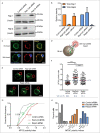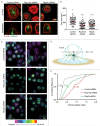The Rap2c GTPase facilitates B cell receptor-induced reorientation of the microtubule-organizing center
- PMID: 29457987
- PMCID: PMC7549615
- DOI: 10.1080/21541248.2018.1441626
The Rap2c GTPase facilitates B cell receptor-induced reorientation of the microtubule-organizing center
Abstract
When B lymphocytes encounter antigen-bearing surfaces, B-cell receptor (BCR) signaling initiates remodeling of the F-actin network and reorientation of the microtubule-organizing center (MTOC) towards the antigen contact site. We have previously shown that the Rap1 GTPase, an evolutionarily conserved regulator of cell polarity, is essential for these processes and that Rap1-regulated actin remodeling is required for MTOC polarization. The role of Rap2 proteins in establishing cell polarity is not well understood. We now show that depleting Rap2c, the only Rap2 isoform expressed in the A20 B-cell line, impairs BCR-induced MTOC reorientation as well as the actin remodeling that supports MTOC polarization. Thus Rap1 and Rap2 proteins may have similar but non-redundant functions in coupling the BCR to MTOC polarization.
Keywords: B cell, B cell receptor (BCR); Rap1; Rap2; microtubule-organizing center (MTOC).
Figures




Similar articles
-
The Rap1-cofilin-1 pathway coordinates actin reorganization and MTOC polarization at the B cell immune synapse.J Cell Sci. 2017 Mar 15;130(6):1094-1109. doi: 10.1242/jcs.191858. Epub 2017 Feb 6. J Cell Sci. 2017. PMID: 28167682
-
Microtubule involvement in NIH 3T3 Golgi and MTOC polarity establishment.J Cell Sci. 2003 Feb 15;116(Pt 4):743-56. doi: 10.1242/jcs.00288. J Cell Sci. 2003. PMID: 12538774
-
Linker for activation of T cells, zeta-associated protein-70, and Src homology 2 domain-containing leukocyte protein-76 are required for TCR-induced microtubule-organizing center polarization.J Immunol. 2003 Jul 15;171(2):860-6. doi: 10.4049/jimmunol.171.2.860. J Immunol. 2003. PMID: 12847255
-
From lipid second messengers to molecular motors: microtubule-organizing center reorientation in T cells.Immunol Rev. 2013 Nov;256(1):95-106. doi: 10.1111/imr.12116. Immunol Rev. 2013. PMID: 24117815 Free PMC article. Review.
-
Activation and function of the Rap1 GTPase in B lymphocytes.Int Rev Immunol. 2001;20(6):763-89. doi: 10.3109/08830180109045589. Int Rev Immunol. 2001. PMID: 11913949 Review.
Cited by
-
Circulating microRNA sequencing revealed miRNome patterns in hematology and oncology patients aiding the prognosis of invasive aspergillosis.Sci Rep. 2022 May 3;12(1):7144. doi: 10.1038/s41598-022-11239-z. Sci Rep. 2022. PMID: 35504997 Free PMC article.
-
Rap1 Is Essential for B-Cell Locomotion, Germinal Center Formation and Normal B-1a Cell Population.Front Immunol. 2021 Jun 1;12:624419. doi: 10.3389/fimmu.2021.624419. eCollection 2021. Front Immunol. 2021. PMID: 34140948 Free PMC article.
-
GLUT3 as an Intersection of Glycerophospholipid Metabolism and the Innate Immune Response to Candida albicans.Front Cell Infect Microbiol. 2021 Jun 18;11:648988. doi: 10.3389/fcimb.2021.648988. eCollection 2021. Front Cell Infect Microbiol. 2021. PMID: 34222036 Free PMC article.
References
Publication types
MeSH terms
Substances
Grants and funding
LinkOut - more resources
Full Text Sources
Other Literature Sources
Molecular Biology Databases
